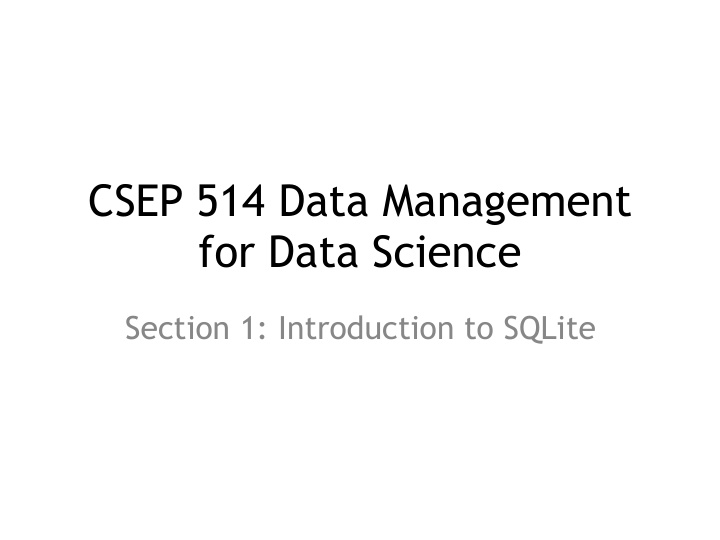



CSEP 514 Data Management for Data Science Section 1: Introduction to SQLite
SQLite: What is it • SQLite is a C library that implements a relational database management system (DBMS). – Simple, lightweight: good for embedded software – But does not provide all of the functionalities that other DBMSs do • sqlite3: a standalone program that can run queries and manage an SQLite database
SQLite: How to Run it (1/2) • On the Linux machines, or Mac: – Open a terminal, then run the command: sqlite3 [database] where "database" is the name of the database file you want to use. – WARNING: If you don't specify a database file, sqlite3 won't complain, but your data will be lost!
SQLite: How to Run it (2/2) • On the Windows machines: – Open a Cygwin terminal, then proceed as if you were on Linux. – If that doesn't work, you may need to install the "sqlite3” Cygwin package from Cygwin Setup. – If *that* doesn't work, try downloading sqlite yourself. • Download it yourself: – Get the "sqlite-shell" binary for your OS from: http://www.sqlite.org/download.html – Extract "sqlite3" or "sqlite3.exe" from the archive and run it from a command line.
SQLite: Basic SQL statements • CREATE - creates a new table ex) CREATE TABLE [table] ( … ); • INSERT INTO - inserts new data into a table ex) INSERT INTO [table] VALUES ([value1], [value2], …); • SELECT - extracts data from a table ex) SELECT [column(s)] FROM [table_name]; • UPDATE - updates data in a table ex) UPDATE FROM [table] SET … WHERE …; • DELETE - deletes data from a table ex) DELETE FROM [table] WHERE …; *Note: Queries are case-insensitive in SQLite
SQLite: SQL keyword, operator, etc • WHERE clause - filter records • AND, OR operator - filter records based on more than one condition • LIKE operator - used in a WHERE clause to search for a specified pattern in a column • AS - give an alias name to a table or a column • Relational operators: =, >, >=, <, <= • Special functions: DATE(…), LENGTH(string), SUBSTR(string, start index, end index), etc References: http://www.sqlite.org/lang.html (SQLite Syntax) http://www.w3schools.com/sql/default.asp (w3school SQL tutorial)
SQLite: Example Teaches Class username dept number dept number title zahorjan cse 378 CSE 378 Machine Organization and Assembly Language tom cse 451 CSE 451 Introduction to Operating tom cse 461 Systems zahorjan cse 451 CSE 461 Introduction to Computer zahorjan cse 461 Communication Networks djw cse 461 levy cse 451 Instructor username fname lname started_on zahorjan John Zahorjan 1985-01-01 djw David Wetherall 1999-07-01 tom Tom Anderson 1997-10-01 levy Hank Levy 1988-04-01
SQLite: . Commands (Not SQL) • .help - list other . commands • .header(s) ON/OFF - show/hide column headers in query results • .mode [mode type]- change how to separate the columns in each row/tuple (for better formatting) • .read [file name] - read and execute SQL code from the given file • .separator [string] - change the separator for output mode or importing files, i.e. .separator , • .nullvalue [string] - print the given string in place of NULL values • .import [file name] [table name] - load the file to the table – be careful to set the separator correctly! • .show - see how we have set our parameters • .exit - exit from sqlite3 References: https://sqlite.org/cli.html (SQLite Command Line Shell)
SQLite: things to watch out for • SQLite allows a key to be null • Older versions of sqlite do not enforce FOREIGN KEY constraints. – Newer versions are opt-in at both compile time and runtime (with PRAGMA FOREIGN_KEYS = ON) • SQLite ignores string length maximums or fixed string lengths: N in VARCHAR(N) or CHAR(N) • SQLite does not have a separate data type for dates, times, or combined date and time. – Instead, these are represented as specially formatted strings; dates are represented as yyyy-mm-dd • And many more as you will discover! References: http://www.sqlite.org/lang.html (SQLite Syntax) http://www.sqlite.org/datatype3.html (SQLite Data type) http://www.w3schools.com/sql/default.asp (w3school SQL tutorial)
Recommend
More recommend